Brighter Scooter Headlights
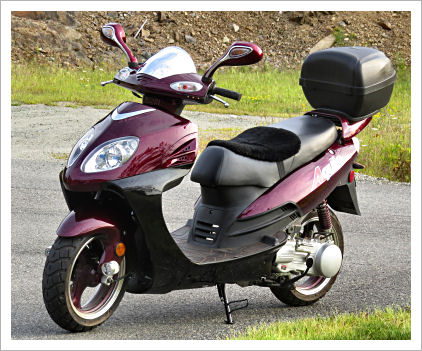
I recently bought a Shenke 150cc "hunter" style scooter. These scooters - which are sold under a dozen different brand names and even more model types - have dual 35/35W headlights. That means each one has a 35W bulb with a dual filaments, one for low beam and one for high beam. With the two headlights on at once you get 70W of light power whether on high or low beam. On low beam they (are supposed to) illuminate the road just head of the scooter and not shine in the eyes of oncoming drivers. On high beam they are aimed higher to (hopefully) illuminate the road further ahead, but would (in theory) dazzle oncoming traffic so must be switched back to low beam if another vehicle approaches.
Now 70W should be enough lighting power to give a pretty bright beam. A typical car might have two 55W bulbs which gives 110W of lighting power. So a scooter headlight system should be about 2/3 as bright as a car. But typically it won't be. Mine gives about as much light as a couple of candles. Well, maybe slightly more, but not enough to really see at night anywhere there isn't street lighting. The beam pattern isn't great either. Light spills out to the sides in a random pattern. Some of it does hit the road ahead of the scooter, so it's better than riding blind - though that's hardly reason for praise. To safely ride at night, better lighting is needed.
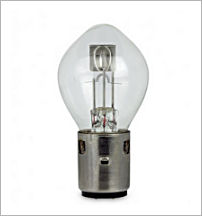 So what can you do? Lets assume you're not going to rip out the scooter headlights and somehow replace them with better designs. What else can you do? Well, you could replace the stock 35/35W bulbs with something brighter. Most car headlight bulbs won't fit, but you can get 45/45W bulbs BA20D 12V
So what can you do? Lets assume you're not going to rip out the scooter headlights and somehow replace them with better designs. What else can you do? Well, you could replace the stock 35/35W bulbs with something brighter. Most car headlight bulbs won't fit, but you can get 45/45W bulbs BA20D 12V bulbs which fit many scooter headlights. Most (but not all) use a bulb with a BA20d base. Check your manual for the exact bulb type your scooter uses. The problem with brighter bulbs is they draw more power and so while they generate more light they also generate more heat. Most scooter headlight assemblies are made of plastic and heat and plastic don't work well together. With higher power bulbs there's a chance you'll melt the headlight assembly. If that happens the bulb position will change and the already fairly poor beam pattern will get worse. The beam could end up pointing up into the sky, right down at the ground or off to one side. You don't really want that. Scooters differ and use different headlight designs and material and it's likely that many may be able to take 45/45W bulbs without a problem. Just be aware of the potential problems if you decide to try even more powerful bulbs (if you can find them) or if you decide to try to modify headlight bulbs from a car to fit your scooter. Bulbs drawing a lot more power could also stress the alternator and battery, neither of which is designed to run heavy electrical loads on a scooter.
Depending on what headlight bulbs you currently have, it's possible you might be able to get a better (brighter) bulb. 35W is how much power the bulb draws, which isn't the same as the amount of light it puts out. Quartz-Halogen bulbs tend to be brighter than non-QH bulbs for example. There's not a huge amount of difference in the illumination they give on a typical scooter, but every little helps and using SAE/DOT approved brighter bulbs of the stock design is perfectly legal. You may see some LED bulbs advertised. Forget them. They could be very bright, but the headlight reflectors aren't designed for them and so the beam pattern will get even worse, plus you won't have a high and low beam. They may have a bright and less bright setting, but low and high beams will still point in the same place. If that's on the road just in front of the scooter they won't help much with distance vision and if they point off into the distance you'll dazzle oncoming traffic (illegal). LED bulbs are also generally illegal in headlights not designed for them. The advantage of LED illumination is that LEDs are much more efficient than tungsten filament bulbs. A 12V LED bulb drawing 3A (36W) will be MUCH brighter than a 12v tungsten filament bulb drawing 3A (36W). An LED might put out 5 to 10x as much light.
You may also see advertising for other types of lights/bulbs and headlight conversions such as HID (High Intensity discharge) systems. They are all illegal. Basically anything you do to the stock headlight other than installing a brighter bulb of the original type is illegal. Manufacturers can fit properly designed HID lights to vehicles but you can't legally put an HID bulb in a headlight reflector that's designed for a tungsten filament bulb because the beam pattern will be wrong (illegal).
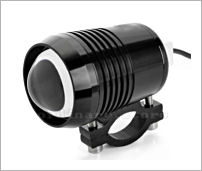 While replacing your stock headlight bulbs with LEDs (or other types of bulb) is illegal, the use of auxiliary lights using LEDs isn't (assuming the lights themselves aren't illegal). Lighting regulations vary from state to state but the most basic regulation which applies everywhere is that any lights you add should not dazzle oncoming traffic and should not interfere with any existing lights on the vehicle. Some states regulate where you can put lights, how many lights you can have and when they can be used. That you'll have to check for whatever state you live in. If you have long range LED lights which illuminate out to a distance like your high beams do, then they MUST automatically go off when you switch to low beam. That applies everywhere. If you have lights that just add more illumination just in front of the scooter like the low beams do, then that can stay on at all times and long as they don't dazzle oncoming traffic. Many LED lights have a fairly wide beam, so even when aimed close to the scooter they may still shine some light out to a distance, which could make them look very bright to oncoming vehicles. Again, you have to consult your states vehicle lighting regulations to be sure what's legal for you in your state.
While replacing your stock headlight bulbs with LEDs (or other types of bulb) is illegal, the use of auxiliary lights using LEDs isn't (assuming the lights themselves aren't illegal). Lighting regulations vary from state to state but the most basic regulation which applies everywhere is that any lights you add should not dazzle oncoming traffic and should not interfere with any existing lights on the vehicle. Some states regulate where you can put lights, how many lights you can have and when they can be used. That you'll have to check for whatever state you live in. If you have long range LED lights which illuminate out to a distance like your high beams do, then they MUST automatically go off when you switch to low beam. That applies everywhere. If you have lights that just add more illumination just in front of the scooter like the low beams do, then that can stay on at all times and long as they don't dazzle oncoming traffic. Many LED lights have a fairly wide beam, so even when aimed close to the scooter they may still shine some light out to a distance, which could make them look very bright to oncoming vehicles. Again, you have to consult your states vehicle lighting regulations to be sure what's legal for you in your state.
One factor to be aware of concerning LED bulbs is that 95% of them are designed to run on DC, not AC. Many scooters use AC to power their headlights. If your headlights only come on once the scooter is started, it's almost certain they are AC powered. If they come on when you turn the key and before you start the scooter, they are definitely DC powered. While you can run LEDs on AC power of the right voltage (12v AC rather than 12v DC) they may not be as bright and they may have a much higher probability of burning out. Some LED lights have circuits built in that allow operation on AC. For those that don't it's not hard to convert the AC to DC using a few diodes and a capacitor in what is called a "bridge rectifier" circuit as shown below.
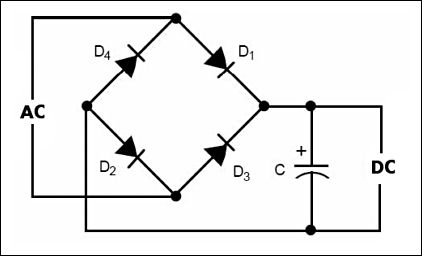
The diodes D1-D4 can be types such as 1N4001, 1N4002, 1N4003 or 1N4004 for LEDS rated at up to about 10W (750mA current). For higher powers (up to about 35W (2.5A current) you can use diodes such as a 1N5400, 1N5401, 1N5402 or 1N5403. You can also get the 4 diodes already connected together - KBPC5010 Diode Bridge. You don't really need the Capacitor C for this application, but it smoothes out the DC a bit. Anything with a rating of 25v or more and a value of 100uF to 1000uF would be fine.
On eBay you will find dozens of auxiliary LED lights designed for cars, motorcycles and scooters. They usually don't comment on legality. Just about anything is legal for off road use, so sometimes with American vendors you'll see things like "for off rod use only". However just because you DON'T see that doesn't mean they ARE legal.
Here's a picture of a pair of small LED lights I added to my scooter. They are located down by the front wheel and point down to the road so they supplement the low beam setting of the headlights. There is some spillover of light out to longer distances, but I don't think there's enough light to dazzle oncoming traffic. They are wired via a switch into to DC part of the electrical system so they can be on when the bike isn't running. You can usually pick up a switched DC line from the wiring harness of the scooter behind the headlight cluster. On just about all bikes, even those with AC powered headlights, the brake light and turn signals operate off switched DC and so provide a tap point for auxiliary LED lighting power.
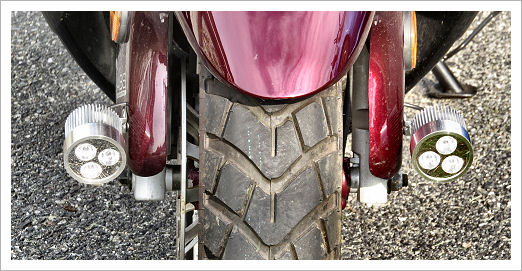
Here's an eBay link to those lights: 9W 12V LED Motorcycle Light. They're bright but, like most LED auxiliary lights, the beam spreads out quite a lot so you need to point them down at the ground if they are always on in order not to dazzle oncoming traffic.
Additional Resources
- Scooter Lighting
- Adding a 12v outlet to your scooter
- Adding an audible turn signal indicator to your scooter
- Adding a digital Speedometer to your scooter
- Scooter oil change
- Scooter maintenance